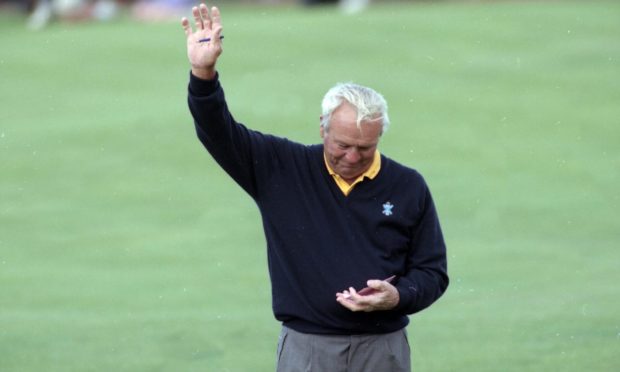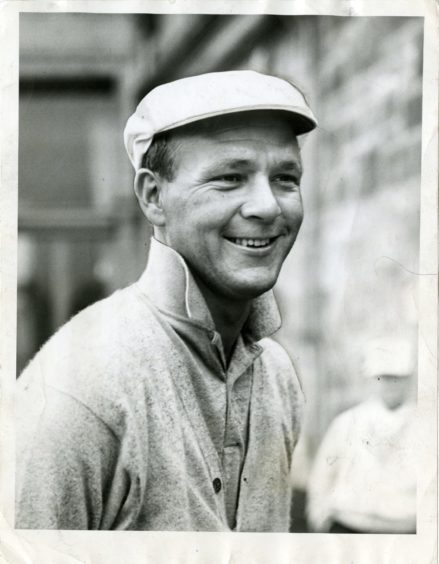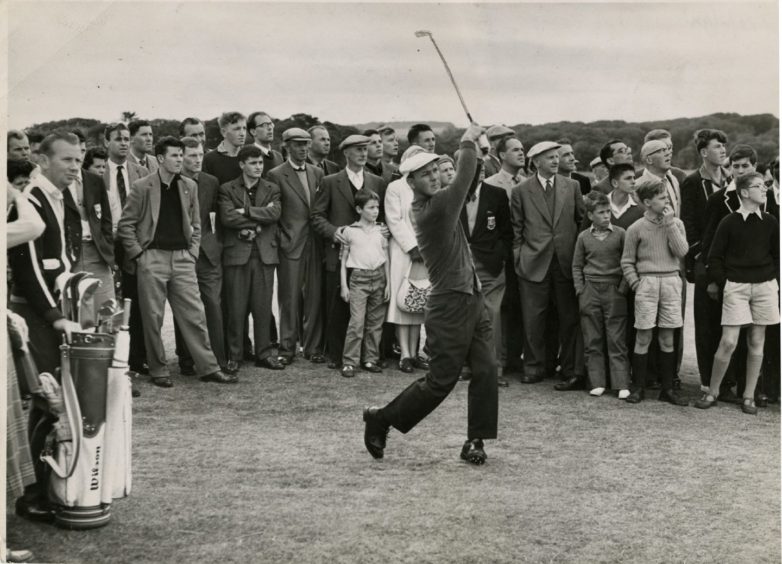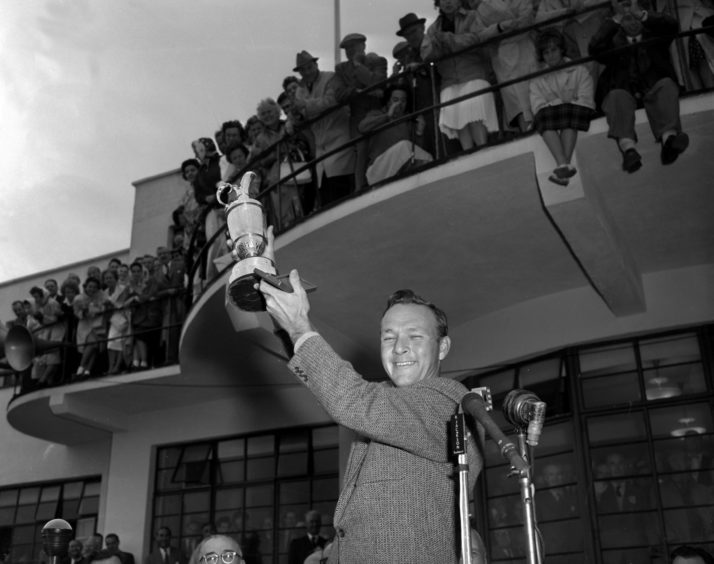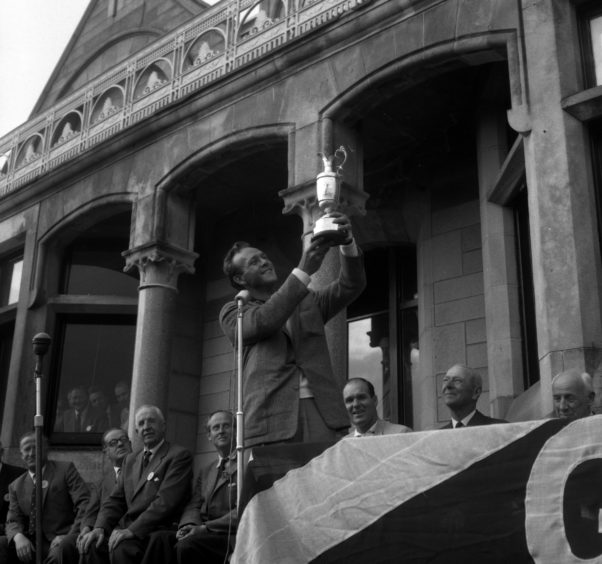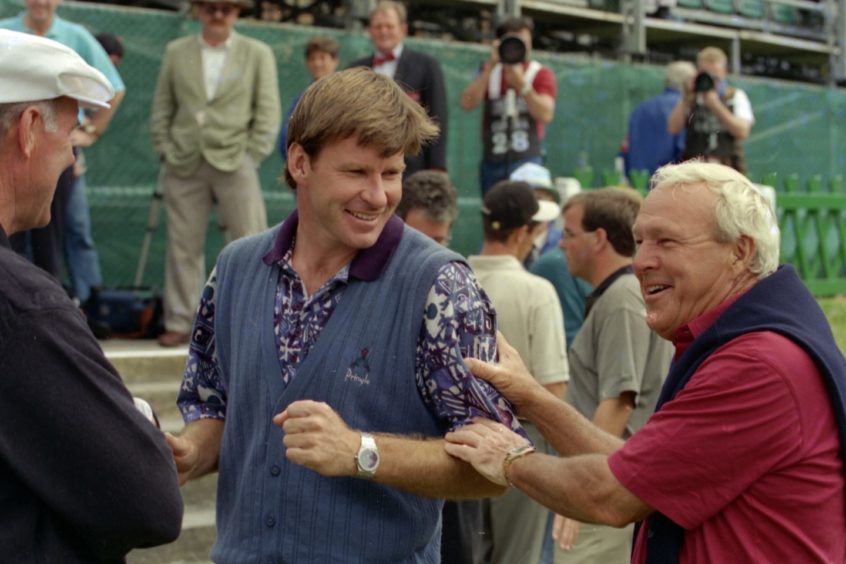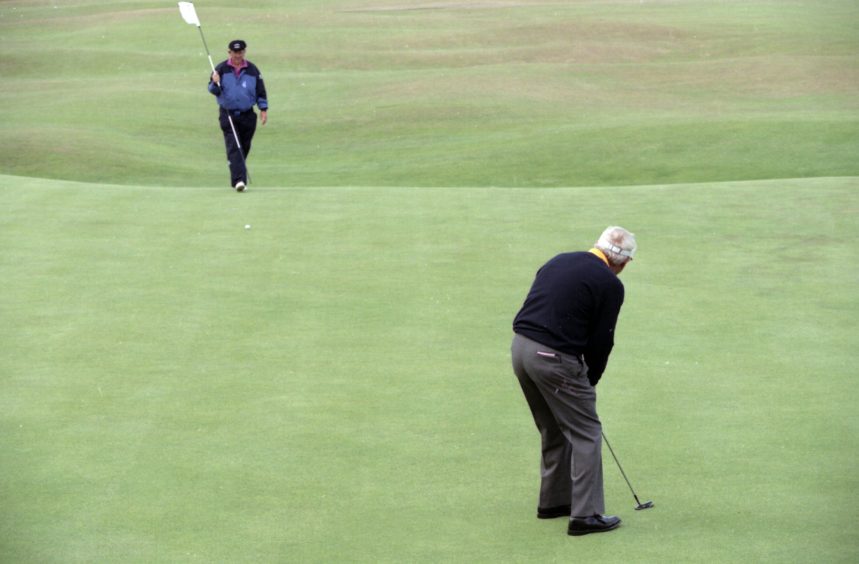He saved the oldest and most prestigious golf major from oblivion 60 years ago in St Andrews.
So it was perhaps fitting that Arnold Palmer’s association with The Open would finally come to an end at the Old Course.
St Andrews paid an emotional farewell to one of its favourite sons 25 years ago after he missed the cut following his second round.
The Open might have been dropped from the major circuit had it not been for Palmer’s decision to come to the centenary championship at St Andrews in 1960.
For many years, few Americans made the overseas voyage to compete in The Open and the event often conflicted with the PGA Championship in the US, which was a more lucrative major.
Most reasoned that two weeks of travel and one week of golf were not worth the relatively measly purse offered by the tournament.
Palmer had won the Masters and the US Open and wanted to win a modern Grand Slam – with The Open and the PGA Championship – in a nod to American amateur Bobby Jones’ efforts in 1930.
Palmer’s decision to take part at the Old Course cemented the status of The Open and secured its future, after years when it seemed top tournament golf was being pulled irrevocably across the Atlantic.
He worked immediate wonders, sending the cash-strapped championship into profit for the first time in years with doubled takings on 1959.
Palmer was four behind Australian Kel Nagle when the rain intervened and flooded parts of the course.
The steps at the eighteenth turned into a waterfall and the Valley of Sin was under three feet of water.
The final round on Friday afternoon was postponed which was the first such interruption in 50 years.
The pumps of the St Andrews Fire Brigade ensured play was possible the following day as Palmer made a heroic last charge, coming home in 34 for a 68.
Nagle, however, hadn’t read the script.
He heard the reaction to Palmer’s closing birdie in the group ahead and held his nerve to hole a par putt at 17 and then another at 18 to win the title by a stroke.
Palmer flew to England the following year for the 1961 Open at Royal Birkdale Golf Club where torrential rain prevented the final 36-holes from taking place and play was suspended until Saturday.
“If necessary, I’m prepared to play in a rowboat,” Palmer declared.
His 69 gave him a one-stroke lead going into the final afternoon round.
Palmer hit an extraordinary shot from a blackberry bush to win the tournament by one stroke.
Palmer won The Open again in 1962 at Royal Troon Golf Club and his presence doubled the gate receipts and signalled the beginning of a golden era for the tournament.
Loved and adored by fans — Arnie’s Army — for his go-for-broke style, Palmer, with the help of Gary Player and Jack Nicklaus revitalised the whole sport.
He was the first client of influential sports agent Mark McCormack, who set up IMG (International Management Group) which was to become the flagship organisation handling stars from other sports like Bjorn Borg and Michael Schumacher.
McCormack listed five attributes that made Palmer especially marketable – his good looks, his modest background, his risk-taking heart-on-his-sleeve golfing style, his involvement in a string of exciting finishes in early televised tournaments and his affability.
Amazingly, that success in 1962 was his last Open triumph, but he remained a superstar and was still cheered by the galleries until his final appearance in 1995.
Palmer got a huge ovation when he left the first tee as he began his last Open, but that was about as good as it got for the 65-year-old elder statesman.
He missed a short putt for his par at the first after just clearing the burn with his second shot, and five further shots went on the outward nine, before he finished with a first round 83.
Palmer bade farewell to The Open the following day and he was given a marvellous send-off by the galleries which were lined eight deep along the 18th fairway and packed into the grandstands on the side of the green.
People were also hanging over the railings of Rusacks Hotel where Palmer had stayed in 1960 to watch him walk up the final fairway and play his last shot on the last hole of his 23rd and last Open.
Palmer removed his hat and waved, acknowledging the loud applause.
Photographers stopped him on the Swilcan Bridge for one last snap to add to a scrapbook filled with some of the most memorable moments in Open history.
Palmer finished with a 75 and missed the cut but it could barely detract from the occasion.
“Today I promised myself that I was not going to get sentimental, so don’t ask me too many questions I can’t answer,” he told a packed media tent afterwards.
“Going up the 18th today I was looking at all the people and all the buildings.
“It was a very warming and happy time for me.
“There are a lot of things and people that have been with me for 40 years that are very important to me.
“The players, the game, the opportunities that this game has given me is something you can never replace.”
While Palmer did not return to play in The Open his clubs were not locked away and he continued to compete in the Masters at Augusta.
In a nice touch, a host of Palmer’s fellow players, including the likes of Nick Faldo and Jack Nicklaus, waited at the top of the steps behind the 18th green to watch him finish and add their applause.
Faldo later summed up the debt owed to Palmer by the game he took to another level.
“What Arnold Palmer has done for The Open is everything,” said Faldo.
“If there had been no Arnold Palmer in 1960, who knows, it might have been a little shed on the beach instead of these salubrious surroundings.”
Other players may have had more successful Open careers than two-time winner Palmer, but it is doubtful whether any will ever have the same impact on the event.
Started golf at the age of four
Born in Latrobe, Pennsylvania, in September, 1929, Palmer took up golf after following his father – a greenkeeper and later club pro – round Latrobe Country Club.
His dad gave him his first club when he was four and in his late teens he won a golf scholarship at Wake Forest University but withdrew during his course when a close friend died.
Palmer shot to fame in 1954, winning the US Amateur at Detroit Country Club, and he turned professional.
His first tour win came at the Canadian Open during his 1955 rookie season.
His first major championship win was that 1958 Masters triumph, where he earned $11,250.
He just missed out on The Open in 1960 at St Andrews, however, he was back to win the next two at Birkdale and Troon, convincing other American pros that a trip to Britain would be worth the effort and securing his popularity among British and European fans.
During the 12 years he played in the Ryder Cup from 1961 until 1973, he accumulated a best ever points record, winning 22 matches and losing just eight with a couple of ties.
That career total of 23 points stood until Nick Faldo reached 25 in 1997.
“I loved the Ryder Cup because it simply wasn’t about playing for money,” said Palmer.
“It was about playing for something far grander and more personal.
“I’m proud of what the Ryder Cup did for me – and for what I contributed to my teams as a player.
“Even though my relationship with the Ryder Cup developed into one that I came to cherish, my earliest experiences of the competition were not of a happy nature.
“It was deeply frustrating to me that I won the 1958 Masters, and nine other tournaments prior to that, but that I was denied the opportunity to collect Ryder Cup points because PGA rules stipulated that I had not been a member of the tour for long enough.
“The injustice stuck in my craw, but whatever hard feelings I privately nursed about being ineligible for the Ryder Cup of 1959 vanished in 1961 when the American squad and our wives walked onto the hushed grounds at Royal Lytham and St Annes for the opening ceremonies.
“I remember standing with my teammates near the first tee and feeling a lump rise in my throat and tears fill my eyes as the brass band played The Star-Spangled Banner followed by God Save The Queen.”
